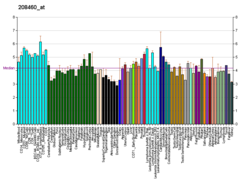GJC1
Appearance
(Redirected from GJA7)
Gap junction gamma-1 protein (GJC1), also known as gap junction alpha-7 protein (GJA7) and connexin 45 (Cx45) — is a protein that in humans is encoded by the GJC1 gene.[5][6]
Function
[edit]This gene is a member of the connexin gene family. The encoded protein is a component of gap junctions, which are composed of arrays of intercellular channels that provide a route for the diffusion of low molecular weight materials from cell to cell. Alternatively spliced transcript variants encoding the same isoform have been described.[6]
References
[edit]- ^ a b c GRCh38: Ensembl release 89: ENSG00000182963 – Ensembl, May 2017
- ^ a b c GRCm38: Ensembl release 89: ENSMUSG00000034520 – Ensembl, May 2017
- ^ "Human PubMed Reference:". National Center for Biotechnology Information, U.S. National Library of Medicine.
- ^ "Mouse PubMed Reference:". National Center for Biotechnology Information, U.S. National Library of Medicine.
- ^ Kanter HL, Saffitz JE, Beyer EC (Dec 1994). "Molecular cloning of two human cardiac gap junction proteins, connexin40 and connexin45". J Mol Cell Cardiol. 26 (7): 861–8. doi:10.1006/jmcc.1994.1103. PMID 7966354.
- ^ a b "Entrez Gene: GJA7 gap junction protein, alpha 7, 45kDa".
Further reading
[edit]- Andrew L Harris; Darren Locke (2009). Connexins, A Guide. New York: Springer. p. 574. ISBN 978-1-934115-46-6.
- Kilarski WM, Dupont E, Coppen S, et al. (1998). "Identification of two further gap-junctional proteins, connexin40 and connexin45, in human myometrial smooth muscle cells at term". Eur. J. Cell Biol. 75 (1): 1–8. doi:10.1016/S0171-9335(98)80040-X. PMID 9523149.
- Vozzi C, Dupont E, Coppen SR, et al. (1999). "Chamber-related differences in connexin expression in the human heart". J. Mol. Cell. Cardiol. 31 (5): 991–1003. doi:10.1006/jmcc.1999.0937. PMID 10336839.
- Chanson M, Scerri I, Suter S (1999). "Defective regulation of gap junctional coupling in cystic fibrosis pancreatic duct cells". J. Clin. Invest. 103 (12): 1677–84. doi:10.1172/JCI5645. PMC 408381. PMID 10377174.
- Kausalya PJ, Reichert M, Hunziker W (2001). "Connexin45 directly binds to ZO-1 and localizes to the tight junction region in epithelial MDCK cells". FEBS Lett. 505 (1): 92–6. Bibcode:2001FEBSL.505...92K. doi:10.1016/S0014-5793(01)02786-7. PMID 11557048. S2CID 13489358.
- Laing JG, Manley-Markowski RN, Koval M, et al. (2003). "Connexin45 interacts with zonula occludens-1 in osteoblastic cells". Cell Commun. Adhes. 8 (4–6): 209–12. doi:10.3109/15419060109080725. PMID 12064590. S2CID 23039209.
- Kaba RA, Coppen SR, Dupont E, et al. (2003). "Comparison of connexin 43, 40 and 45 expression patterns in the developing human and mouse hearts". Cell Commun. Adhes. 8 (4–6): 339–43. doi:10.3109/15419060109080750. PMID 12064615. S2CID 23388741.
- Xiang Q, Fan SQ, Li J, et al. (2003). "[Expression of connexin43 and connexin45 in nasopharyngeal carcinoma]". AI Zheng. 21 (6): 593–6. PMID 12452056.
- Strausberg RL, Feingold EA, Grouse LH, et al. (2003). "Generation and initial analysis of more than 15,000 full-length human and mouse cDNA sequences". Proc. Natl. Acad. Sci. U.S.A. 99 (26): 16899–903. Bibcode:2002PNAS...9916899M. doi:10.1073/pnas.242603899. PMC 139241. PMID 12477932.
- Tsai MY, Lan KC, Huang KE, et al. (2004). "Significance of mRNA levels of connexin37, connexin43, and connexin45 in luteinized granulosa cells of controlled hyperstimulated follicles". Fertil. Steril. 80 (6): 1437–43. doi:10.1016/j.fertnstert.2003.05.015. PMID 14667880.
- Ota T, Suzuki Y, Nishikawa T, et al. (2004). "Complete sequencing and characterization of 21,243 full-length human cDNAs". Nat. Genet. 36 (1): 40–5. doi:10.1038/ng1285. PMID 14702039.
- Valiunas V, Doronin S, Valiuniene L, et al. (2004). "Human mesenchymal stem cells make cardiac connexins and form functional gap junctions". J. Physiol. 555 (Pt 3): 617–26. doi:10.1113/jphysiol.2003.058719. PMC 1664864. PMID 14766937.
- Brandenberger R, Wei H, Zhang S, et al. (2005). "Transcriptome characterization elucidates signaling networks that control human ES cell growth and differentiation". Nat. Biotechnol. 22 (6): 707–16. doi:10.1038/nbt971. PMID 15146197. S2CID 27764390.
- Gerhard DS, Wagner L, Feingold EA, et al. (2004). "The status, quality, and expansion of the NIH full-length cDNA project: the Mammalian Gene Collection (MGC)". Genome Res. 14 (10B): 2121–7. doi:10.1101/gr.2596504. PMC 528928. PMID 15489334.
- Kimura K, Wakamatsu A, Suzuki Y, et al. (2006). "Diversification of transcriptional modulation: large-scale identification and characterization of putative alternative promoters of human genes". Genome Res. 16 (1): 55–65. doi:10.1101/gr.4039406. PMC 1356129. PMID 16344560.
- Laing JG, Koval M, Steinberg TH (2007). "Association with ZO-1 correlates with plasma membrane partitioning in truncated connexin45 mutants". J. Membr. Biol. 207 (1): 45–53. doi:10.1007/s00232-005-0803-2. PMID 16463142. S2CID 20032015.
- Rackauskas M, Kreuzberg MM, Pranevicius M, et al. (2007). "Gating properties of heterotypic gap junction channels formed of connexins 40, 43, and 45". Biophys. J. 92 (6): 1952–65. Bibcode:2007BpJ....92.1952R. doi:10.1529/biophysj.106.099358. PMC 1861779. PMID 17189315.
- Kotsias BA, Salim M, Peracchia LL, Peracchia C (2007). "Interplay between cystic fibrosis transmembrane regulator and gap junction channels made of connexins 45, 40, 32 and 50 expressed in oocytes". J. Membr. Biol. 214 (1): 1–8. doi:10.1007/s00232-006-0064-8. PMID 17546509. S2CID 7095255.
External links
[edit]- GJC1 human gene location in the UCSC Genome Browser.
- GJC1 human gene details in the UCSC Genome Browser.





